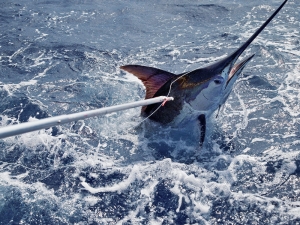
A new TBF-supported study out of the University of Miami made great strides in understanding the relationship between age and growth of Atlantic blue marlin.
What Did It Do?
The study examined growth annuli in anal fin spines of 1,638 blue marlin caught as bycatch in Venezuela to determine the age of each fish. Growth annuli are small rings inside of the fin spine that increase in number as the fish ages, much like the rings in a tree trunk. They then correlated this age information to the lower jaw fork length (LJFL) to determine how well LJFL predicts fish age.
What Did It Find?
The study found that the maximum age of Atlantic blue marlin was 43.4 years for males and 43.5 years for females. It also found that the size range for Atlantic blue marlin is 130 – 254 cm LJFL for males and 126 – 370 cm LJFL for females. Most importantly, the study found that there is not a perfect linear relationship between age and LJFL in Atlantic blue marlin. This is because the largest fish in their sample were not the oldest. However, they were able to create non-linear models that can predict age from length with a high degree of certainty. Scientists and policymakers will use these models in the future to help determine the age of bycaught fish.
Why Does It Matter?
This study was desperately needed due to a lack of reliable age and growth information on Atlantic blue marlin. In fact, this study now represents the most comprehensive sample for age and growth analysis of Atlantic blue marlin ever. The results of this study, and the growth models that it was able to generate, will help reduce uncertainties in stock assessment analyses in Atlantic blue marlin because now researchers will know how old most blue marlin are when they are caught as bycatch. This knowledge of bycatch age has large implications for understanding how commercial and recreational landing of blue marlin affects the overall population. This will help ensure that all policies and size regulations made to protect Atlantic blue marlin are done so with scientific backing, thereby increasing the likelihood that the conservation goals that the policies are created for are met.
To see more studies that TBF has supported, be sure to check out the publications page of our website. To stay up-to-date on billfish research, policy, and news, subscribe to our newsletter, become a member, or follow us on social media, @TheBillfishFoundation.






